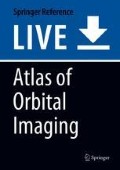Abstract
Imaging of the orbitofacial skeleton and soft tissues – including the globe, the face, and intracranial structures, is an essential component in the diagnosis, counseling, prognostication, management, and follow-up of patients afflicted by trauma to the craniofacial region, which has both medical and medicolegal consequences. We herewith provide an overview of the various imaging modalities (ultrasound, CT scan, Magnetic resonance imaging, angiography), and common radiologic features. A thorough knowledge is thus paramount to the practicing ophthalmologist managing these complex conditions.
In general, Computed Tomography (CT scan) is the imaging modality of choice for orbital trauma and foreign bodies. However, Magnetic Resonance Imaging (MRI) may be considered in special circumstances as it may be more sensitive in the detection and assessment of nonmetallic/organic intra-orbital foreign bodies. Black bone MRI is increasingly being used nowadays or orbital imaging, especially in children, who need repeated imaging of the soft tissues and the bone.
References
Almousa R, Amrith S, Mani AH, Liang S, Sundar G. Radiologic signs of periorbital trauma – the Singapore experience. Orbit. 2010;29(6):307–12.
https://eyewiki.org/Imaging_in_Ocular_and_Ocular_adnexal_trauma
Ting E. Imaging in orbital & orbitofacial fractures. In Orbital fractures – principles, concepts & techniques. Imaging Science Today LLC. ISBN-13:978-0997781922.
Shintaku W, Venturin J, Azevedo B, Noujeim M. Applications of cone-beam computed tomography in fractures of the maxillofacial complex. Dental Traumatol. 2009;25:358–66.
Practical classification of Orbital & Orbitofacial Fractures. In: Sundar G, editor. Orbital fractures – principles, concepts & management. Imaging Science Today LLC. ISBN-13: 978-0997781922.
Kakizaki H, Zako M, Katori N, Iwaki M. Adult medial orbital wall trapdoor fracture with missing medial rectus muscle. Orbit. 2006;25(1):61–3.
Attoya KA, Mirvis SE. Radiological evaluation of the craniofacial skeleton. In: Dorafshar AH, Rodriguez ED, Manson PN, editors. Facial trauma surgery – from primary repair to reconstruction. Elsevier; 2020. ISBN: 978-0-323-49755-8.
Udhay P, Bhattacharjee K, Ananthanarayanan P, Sundar G. Computer-assisted navigation in orbitofacial surgery. Indian J Ophthalmol. 2019;67:995–1003.
Friedrich RE, Bruhn M, Lohse C. Cone-beam computed tomography of the orbit and optic canal volumes. J Craniomaxillofac Surg. 2016;44(9):1342–9.
Eley KA, McIntyre AG, Watt-Smith SR, Golding SJ. “Black bone” MRI: a partial flip angle technique for radiation reduction in craniofacial imaging. Br J Radiol. 2012;85(1011):272–8.
Freund M, Hähnel S, Sartor K. The value of magnetic resonance imaging in the diagnosis of orbital floor fractures. Eur Radiol. 2002;12:1127–33.
Author information
Authors and Affiliations
Corresponding author
Editor information
Editors and Affiliations
Rights and permissions
Copyright information
© 2021 Springer Nature Switzerland AG
About this entry
Cite this entry
Sundar, K., Sundar, G. (2021). Orbital Trauma: Orbital and Orbitofacial Fractures. In: Ben Simon, G., Greenberg, G., Prat, D. (eds) Atlas of Orbital Imaging . Springer, Cham. https://doi.org/10.1007/978-3-030-41927-1_116-1
Download citation
DOI: https://doi.org/10.1007/978-3-030-41927-1_116-1
Received:
Accepted:
Published:
Publisher Name: Springer, Cham
Print ISBN: 978-3-030-41927-1
Online ISBN: 978-3-030-41927-1
eBook Packages: Springer Reference MedicineReference Module Medicine

